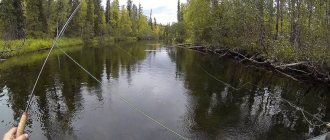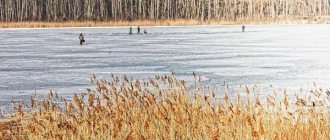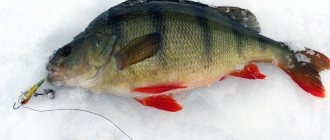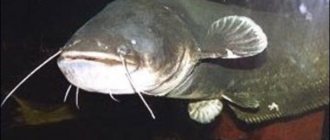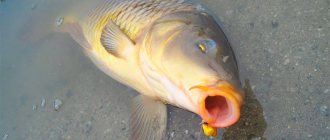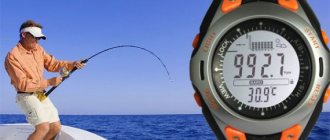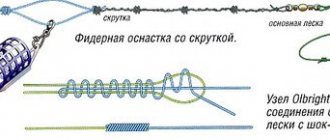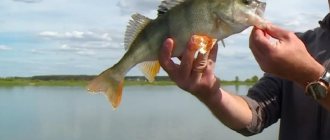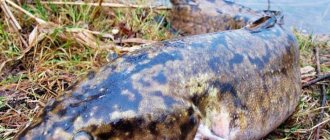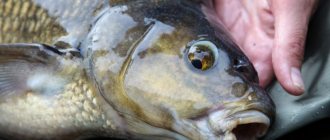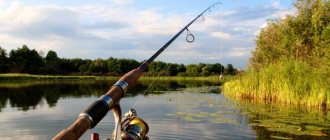Places to catch bream in autumn. When does bream bite better in the fall? What bait do fishermen use? Catching bream with a ring, fly and side fishing rod in the fall. Gear in strong currents.
With the onset of autumn cold, bream, like many other fish, begin to move to deeper places, which for some aquatic inhabitants serve as wintering pits, and for others as overnight stops before going out to feed. Bream is one of these fish. It is not as active in autumn and winter as perch and pike, but nevertheless does not go into deep hibernation like tenches and other cyprinids, which you cannot wake up in late autumn and winter.
Already in September, the places for catching bream change
If you take a small river, then the best points for effective fishing will be the spits and edges next to the hole, especially if the hole is snaggy and deep. In such places, the most successful tackle for catching bream in the fall will be a feeder. Usually they choose for fishing a gently sloping sandy bank, which gradually drops and goes into the depths to the opposite steep bank, under which lie bog oaks and spruce trees.
It is better to make the first test casts with a marking weight, trying to place it closer to the hole, so that when returning it to the shore, you can determine the presence of snags, and most importantly, the point where the hole turns into a sloping slope. Usually such a place is uneven. This edge is washed away by the current, since grass grows in a shallower place and mollusks live - often toothless and less often pearl barley. These plants and shellfish strengthen the soil. Therefore, the boundary between a clean sand pit at the bottom and a riffle is usually noticeable when the marker weight moves. And since life is in full swing at this border, then, naturally, fish come here to feed. This means that it makes sense to first feed such a place with feeders without leashes and hooks. Usually 10 bait feeders are enough to feed a point. At this time, you can already start using winter baits for cold water. After feeding the point, you can start fishing.
Bream behavior in autumn
Bream does not like warm water and currents, and this is one of its main differences in habits from many other fish. This feature allows fishermen to fish for bream from the shore even in late autumn. While the rest of the fish have gone to depth and, with rare exceptions, appear near the coastline in isolated cases, bream, not particularly reacting to temperature changes, continues to swim near the shore. But, on the other hand, this circumstance forces principled bream hunters, even on warm days at the beginning of autumn, to go to the depths in search of it. On hot days, this fish settles in pit areas, which forces anglers to expand their fishing territory.
The behavior of bream in autumn can be divided into two periods: 1) from September to mid-October; 2) from mid-October to the end of November. The first period is characterized by almost the same fish behavior as in the summer. In the heat, it is difficult to catch bream near the shore, because in such weather it settles in holes, and swims to the shore only after the heat subsides. From mid-autumn, on the contrary, you can often come across bream in the coastal zone. At this time, it leaves deep shelters and approaches the shore, where the water is colder and tasty food is available. Bream has a good appetite, which allows it to maintain the necessary level of fat for life in cold waters. For this reason, bream caught in the fall always have a lot of fish oil.
IMPORTANT! From the beginning of October, the bream bite intensifies. Large bream appear near the shore closer to night, when the water temperature drops even lower. The larger the bream, the lower the temperature it needs for a comfortable life
When November comes, the bream begins to return to the depths and look for really large holes for wintering. The activity of the November bream decreases; like other fish, it becomes picky about food, which it no longer consumes as much as in the past months of autumn.
What do you use to catch bream in the fall?
In the fall, bream begins to peck at the worm more and more willingly. If in summer vegetable baits were more attractive, now, before winter, the fish need calories. Therefore, worms and worm “sandwiches” with maggots are best suited .
But with morning frosts, bloodworms will often become the most effective bait. For attaching to a feeder hook, the bloodworm is, of course, rather weak. It will leak out and will be unsuitable for fishing in the first minutes. Therefore, it is better to tie bloodworms into tassels. For this, there are special devices where the bloodworm is placed in a tube, and an elastic band is thrown over the larvae, tying the bloodworm into a tassel.
Catching bream with a fishing rod
Catching bream in the fall with a fishing rod can also be successful if the place is chosen correctly. Usually this is a fairly deep hole in which the reverse current slowly circles, and then there is a stream of moderate current. There is usually vegetation along this boundary. This is where you should throw the baited hook. If space allows, it is better to use a fly rod made of carbon fiber with a bloodworm hook attachment. The bait is thrown to the bottom. Fishing is done in a retrieve when the hook is dragged along the sandy bottom. Any stop of the float should attract attention. Often such fishing is most effective on a small river in the fall.
Bait is also necessary in such places and with this method of fishing. It is thrown above the fishing point in the form of large and fairly dense balls.
Habits of bream and its fishing in late autumn
Due to the fact that bream in reservoirs and lakes, as the water gets colder, stops approaching the shore during the daytime, its fishing comes down to two options. For night fishing and daytime boat fishing.
During the day, bream can stand on the bait, but not bite, sensing the presence of the angler. In order to effectively fish at night, you need to not only prepare the fishing spot in the evening, but also feed the bream. Preparing the place means that the fish tank, stands, and seat should be arranged in the same way as they will be located during the fishing process. It's too late to do this at night. Then you need to assemble the rod and carefully measure the depth and study the bottom topography. After measuring the depth, I advise you to get or make a spare rig and immediately install a “working” trigger on it, or even better, don’t be lazy and install the trigger on two spare rigs. Then you can move on to bait.
Since you have to feed before dark, and also due to the fact that after the water is released, a noticeable current may appear in the reservoirs, you should take a relatively large amount of bait with you. For effective fishing on an autumn night, the amount of bait can reach several kilograms with the addition of a liter of maggots. This is due to the fact that the bream actively feeds at night, and if the amount of bait lying on the bottom runs out, then the bream does not leave this place, but stops pecking. It is not worth feeding at night. Large fish don't like things falling from above. She becomes wary and freezes. If you throw one or two balls of bait at the fishing point, the break in the bite can last for one and a half to two hours. But this is not the rule, of course, there are exceptions that it is better not to count on. Therefore, it is better to calmly prepare 4-6 kg of high-quality bait in the evening (taking into account the dilution of the bait with earth and sand) and immediately after sunset feed the selected place, throwing approximately 80 percent of the bait into it.
For bait, I use basic domestic formulations for cold water with a high content of corn. If the bottom current is noticeably strong, then I add a little millet porridge to the bait.
It is very good to add small bloodworms at the rate of 100 g of bloodworms per kilogram of dry bait, but it is even more important to introduce maggots into the bait. Fishing experience suggests that regardless of what bream prefers to bite on today, the bait should contain food elements of both plant and animal origin. And maggot in “bream” bait definitely and always dramatically increases the effectiveness of its action. The total volume of maggots in 6-8 kg of bait mixture can be half a liter. If there is hope for a large fish to approach, then instead of bloodworms I add a couple of handfuls of chopped worms.
You can fish with a long fly rod, but it is better to use a pole with a shortened rig. Both fishing options have their pros and cons. For most anglers, working with a fly rod is simple and familiar. This is dignity. The disadvantages include the fact that the fly rod does not allow you to absolutely accurately deliver the bait to the fishing point. This is impossible because there are no landmarks at night. Surface currents can quickly carry away equipment, and this is also difficult to control, again due to the lack of visual references. It is almost impossible to remember the bite point. If there are no bites for a long time, then the fisherman finally loses his bearings.
Using a plug rod allows you to get rid of all such problems. The biggest technical problems for an angler during night fishing arise when designing a float rig in which the traditional antenna is replaced by a “firefly”. It seems to me that this problem can be solved quite simply: take almost any float with a carrying capacity of 1.5-2.5 g with a thick antenna, which is removed from the body of the float, and a “firefly” is inserted in its place. An example of such a float is shown in photo 1. You can do it differently. Stretch the silicone casing over the firefly and place it on the antenna.
| Photo 1 |
| Photo 2 |
Despite the fact that bream bites more accurately at night, it is preferable to use bloodworms or small dung worms as bait on the hook. We can discuss for a long time why bream prefers these baits in the fall, but the most important thing for the angler is that these baits are the most effective and attractive for bream. Very good results can be obtained by using caddis flies, bloodworms with maggots and steamed “barley” as bait, as well as white bread in the form of a “bow”. In the daytime, the fish moves away from the shore, then it makes sense to use either a feeder or “long casting”. This is not very convenient on reservoirs, since frequent snags near the shore and waves interfere, but if the weather is calm, then you can fish.
With further cooling of the water, bream stops coming to the upper edge and catching it from the shore using float and even feeder rigs becomes problematic. It is very convenient to fish with long casting from a boat, since the fishing distance is small, but sufficient so as not to alert the fish. There is no point in fishing from a distance of more than 20-25 meters. Having chosen a place, they set up a buoy and feed them three to five meters from the designated point. After this, the boat is positioned on the windward side so that it is convenient to cast downwind. This makes it possible to pull up the equipment and let it drift to the fishing point. Before installing the boat, you need to measure the depth as accurately as possible in the chosen fishing spot and set it up on the rig. It is better to use heavy equipment, with floats with a lifting capacity of up to 20 g, with a replaceable weight built into the keel.
At the bottom of the sliding float there is a keel, which is threaded into the body of the float. The keel has removable washers of varying weights. I usually assemble the equipment as follows. I measure the fishing depth, for example, it is 6 meters. I stop the float on the fishing line, place a sliding sinker weighing six grams below, after which I remove so many washers from the keel of the float so that the float is slightly underloaded. After this, I load the float with additional padding.
The normal position of the float in the water depends on what kind of attachment the angler is going to use and what type of wiring. If fishing is done with maggots or bloodworms, then the antenna of the float should protrude literally 3-5 mm from the water. If you plan to use a large bait in the form of a worm, then the load is selected in such a way that the antenna protrudes 15-30 mm above the surface of the water. If the equipment has to be anchored, then you need to select a feed appropriate to the wind and water waves. It’s better to think everything through at the very beginning of fishing and not suffer in the future.
When fishing from a boat, you must have a plastic bucket for bait, a landing net with a diameter of at least 40 cm with a long handle and a spacious fish tank. After the boat is anchored, you need to remove the oars and put them aside. It is not advisable to have metal buckets or pots with bait in the boat. Sound travels through water very well and quickly; accidentally dropping a thermos to the bottom of the boat can ruin all your efforts to prepare for fishing.
Fishing in the fall is complicated by the fact that bream, like other peaceful fish, leads an unpredictable lifestyle. But, in my opinion, this is not the most important thing. In autumn, the fish are sluggish, the bites are as cautious as in winter, but the tackle (compared to ice fishing) is thick, heavy and rough. It often happens that fishing conditions do not allow the use of thin tackle, and bites on coarse tackle are simply not visible. This contradiction is now fully evident.
Andrey Yanshevsky October 23, 2012 at 00:00
Catching bream from a boat using a ring and an onboard fishing rod
On a large river in the warm autumn period, the most effective way to catch bream from a boat using rings and side rods.
In deep places with strong currents, “rings” are usually used, where the cord of a heavy feeder is connected using a movable lead ring to the main line of the donkey. The ring is also a sliding sinker for the donkey. When the ring with leads is lowered along the cord onto the lid of the feeder, the hooks with bait are always in a cloud of washed-out bait. (details about catching bream with a ring)
In smaller areas with moderate currents, it is better to use side rods, which are larger analogues of a winter fishing rod with a nod. The equipment is made in the form of a feeder with a leash tied above.
Pinwheels for perch
Pond on Chestka
Tactics for catching bream in autumn
If fishing is planned at night, then the place needs to be fed in the evening. Complementary foods are thrown in small portions with an interval of 15-20 minutes at one point. It is most effective to feed the area over several days. It is worth keeping noise to a minimum, since bream has good hearing, which becomes even more acute in the fall. If you go fishing on a boat, do it without a motor. Its noise can frighten the fish, which are already extremely cautious at this time. You should turn off the engine 100 meters before the planned fishing spot. Fishing for bream from the shore involves quiet and smooth casting with a fishing rod. To learn how to perform them, you will have to practice a little. The ideal option is to carefully lower the hook from a bridge or cliff.
IMPORTANT! Despite the fact that with the onset of severe cold weather, bream begins to move slowly and seems like an easy prey, once hooked, it seems to gain new strength and begins to break free with the same tenacity that is characteristic of it in the summer
If there is a strong current, casts should be made in its direction so that the water currents do not put so much pressure on the line. When the bream is hooked, it will begin to break free, moving towards shelters from snags and bushes. It must not be allowed to swim there, otherwise the fisherman risks being left not only without fish, but also damaging his gear, which will be very difficult to untangle among rotten trees and snags. Here you either need to have time to fish him out, or, if he nevertheless dived into the shelter, cut off the fishing line yourself in order to avoid further difficulties. It is always more difficult to catch bream in the current, because it has more developed fins than its counterparts from calm waters. Therefore, after hooking, there is no need to make sudden movements, let the fish get a little tired and calm down. You need to pull him towards you gradually, but not too slowly so that he doesn’t rush towards the shelter. Swing the rod left and right, reeling in the line at low speed. This style of fishing will confuse the bream, and it will begin to lose its bearings - now its jerks should be reduced. Experienced fishermen know that a bream caught from a school will take a long time to try to return to the school, so you will have to tinker with it quite a bit.
Fishing efficiency will help increase the search for schools of fish. If you find a bream, it means that there are larger individuals lurking somewhere nearby, because bream and bream are found in the same school.
Night fishing for bream in autumn
Starting from mid-October, bream become active at night. It can be found both at medium depths and in coastal zones. There is a good chance even in November to catch bream using a float rod from the shore. It can often be caught within the boundaries of large cities, where there is a lot of light and fishing takes place in comfortable conditions. Before night fishing, you should feed the area well, and then throw out the gear and wait for a bite. With the onset of twilight, small bream will approach first, but by midnight they begin to actively peck large specimens. Bream activity at night reaches several hours.
Due to the fact that bream becomes extremely cautious and inactive towards the end of autumn, many fishermen begin to have problems in the process of feeding them. At such times, you need to avoid unnecessary noise and even lower complementary foods smoothly, without unnecessary movements. And if at the beginning of autumn complementary food can be thrown even with a slingshot, then from mid-November it must be immersed in water very carefully and smoothly. How to deliver complementary foods silently right to the biting point? You should attach a plastic cup to the retractable plug, where the bait is placed. The plug reaches the fishing area and turns over - the bait is submerged smoothly and almost silently into the water. The main thing during supplementary feeding is not to rush, dropping complementary foods from the cup no earlier than every 10 minutes. Food balls can be sculpted to the size of a table tennis ball.
It is very important not to overdo it with bait. And the point here is not even that the fish will eat enough and stop being interested in the bait, but that the level of concentration of odors at the fishing point may exceed the permissible level. And if this happens, the bream will quickly leave the place. This mistake is made by fishermen in the fall. Many of them are for
